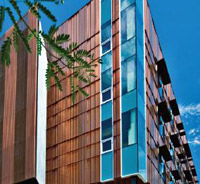Past, Present and Future: Copper Continues to Be a Construction Mainstay
Durability, longevity and high resistance to corrosion make copper attractive for builders
 The Arizona State University College of Nursing and Health Innovation.
The Arizona State University College of Nursing and Health Innovation.Photo Credit: Liam Frederick and Bill Timmerman
High-resolution version of this photo.
When starting a new building project or renovating an existing one, choosing which materials to turn to usually relies on two key components – aesthetics and performance. Regardless of the economic times, if there is a product that is highly desirable, it is not going to disappear.
Even with the weakened building and construction market, copper remains the preferred choice by architects, builders and developers designing commercial projects because its inherent qualities remain unmatched by other materials.
Mark Roddy is the AIA Design Principal for the SmithGroup in Phoenix and handles many of the new building projects in Arizona, and other areas in the southwest. Roddy said his firm will utilize copper for many types of building and construction applications because of its durability, longevity, high resistance to corrosion and sustainability attributes.
“We’ll choose copper over other materials because it’s almost alive,” said Roddy, referring to the metal’s ability to form a patina. “You never know exactly what you’ll get. It has a natural quality that makes it gorgeous.”
Earlier this year, Roddy submitted two building projects that both earned the SmithGroup a coveted 2011 North American Copper in Architecture (NACIA) award from the Copper Development Association (CDA).
The SmithGroup was recognized by CDA for the Arizona State University College of Nursing and Health Innovation Phase 2 and the Apollo Development Corporation Riverpoint Center projects. Both are excellent examples of how architectural copper can be adapted to achieve a wide variety of contemporary and cutting-edge applications. These, and other 2011 NACIA projects, can be viewed at www.copper.org.
While cost does play a role in any project, it’s not always the deciding factor in material selection.
“Budgets are always tight,” Roddy said. “Between copper, zinc, stainless steel and aluminum, they all have different visual properties. So, the ‘big idea’ behind a project will dictate what material will be selected.”
Copper, brass and bronze are frequently used for roofing systems, wall cladding applications, flashing, gutters and downspouts, as well as to structurally or aesthetically enhance other architectural features.
While Roddy doesn’t specify copper for every new project he’s designing, he will consider it when an appropriate application comes along. Currently, he has two projects in the works that will incorporate copper.
“[With copper] you know you’re going to get a professional product that lasts a long time. Everyone really responds to it and it’s always very identifiable.”
Heather & Little located in Ontario Canada, has received several NACIA awards over the years for their innovative use of copper in restoring and renovating historic buildings.
“In the past decade, we are seeing the use of copper in building architecture more so,” said Cameron Forbes, vice president of Heather & Little. “The metal’s longevity and low maintenance play a major role in its continued popularity.”
Another advantage to using copper is its versatility. There is a vast selection of copper alloys, available in numerous finishes and colors, from which designers can choose, giving them a creative freedom not possible with most other materials.
“Copper lends itself well to just about every type of building. Regional preferences and climate don’t appear to play a major role when designing copper; it is widely used throughout North America,” Forbes said. “As for cost, when comparing copper with other types of materials, in many cases it’s less expensive when its lifespan or years of serviceability are taken into consideration.”
So, while nobody can predict exactly what the building and construction market will do in the future, copper will surely be a mainstay as it has been for centuries before. Cu
Also in this Issue:
- Staying Cool with Copper
- Copper Cabling Speeds Communications on Medical Campus
- Copper Provides Protection Underneath the Surface
- Past, Present and Future: Copper Continues to Be a Construction Mainstay
- Hospitals Turn to Copper for Reliability Where It Matters Most
